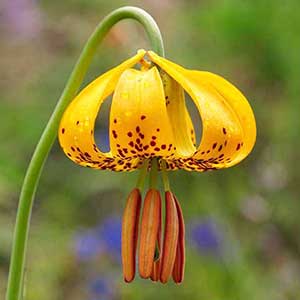Lilium rubescens
Lilium columbianum
chaparral lily, redwood lily
Columbia lily, Columbia tiger lily, Columbian lily, Oregon lily, tiger lily
± ovoid, 3.9–9.4 × 2.5–7.1 cm, 1.1–2.6 times taller than long;
scales unsegmented, longest 4–8.9 cm;
stem roots absent.
variable, subrhizomatous to ± ovoid, 3.1–8.1 × 3.6–10.6 cm, 0.3–1.4 times taller than long;
scales 2–3(–5)-segmented, some unsegmented, longest 3.1–7.3 cm;
stem roots absent.
to 2 m, often glaucous.
to 1.7 m, glaucous or not.
rounded in cross section.
rounded in cross section.
in 3–5(–more) whorls or partial whorls, 3–15 leaves per whorl, usually ± ascending, sometimes horizontal and drooping at tips, 3.2–12.3 × 1–2.8 cm, 2–6.4 times longer than wide;
blade oblanceolate, sometimes obovate, rarely elliptic, margins usually undulate, apex acute, often widely so, or obtuse;
veins and margins ± smooth abaxially.
in 1–9 whorls or partial whorls, 3–25 leaves per whorl, usually ascending, 1.7–15.7 × 0.4–4.7 cm, 2.4–7.4 times longer than wide;
blade weakly oblanceolate to obovate or ± elliptic, margins usually somewhat undulate, apex acute;
veins and margins ± smooth abaxially.
racemose, often with flowers in loosely defined whorls, 1–40-flowered.
racemose, 1–25(–45)-flowered.
ascending to erect, fragrant;
perianth funnelform;
sepals and petals recurved 1/2–2/3 along length from base, white, aging pink-purple, with fine magenta spots concentrated proximally or less often generally distributed, often reddish or purplish abaxially, not distinctly clawed;
sepals not ridged abaxially, 4.3–6.6 × 0.6–1.4 cm;
petals noticeably wider than sepals, oblanceolate and often very wide proximally, 4.2–6.4 × 0.9–1.9 cm, apex widely acute, obtuse, or rounded;
stamens included;
filaments barely spreading, diverging 3°–12° from axis;
anthers pale yellow, 0.4–0.8 cm;
pollen yellow;
pistil 2.7–3.8 cm;
ovary 1.2–1.8 cm;
style pale green;
pedicel 1.4–9.5 cm.
pendent to nodding, not fragrant;
perianth Turk’s-cap-shaped;
sepals and petals reflexed 2/5–1/2 along length from base, yellow or orange to occasionally red, with copious maroon spots, often darker and especially reddish abaxially, not distinctly clawed;
sepals not ridged abaxially, appearing wide for their length, 3.4–7.1 × 0.8–1.9 cm;
petals 3.5–6.9 × 0.8–1.9 cm;
stamens barely to moderately exserted;
filaments moderately spreading, diverging 10°–20° from axis;
anthers pale yellow to yellow, 0.5–1.3 cm;
pollen orange or yellow;
pistil 2.4–3.7 cm;
ovary 1.1–2.2 cm;
style green;
pedicel 2.8–20.2 cm.
usually with 6 longitudinal ridges, 2–3.7 × 1.7–2.7 cm, 1.1–1.7 times longer than wide.
2.2–5.4 × 1.1–2 cm, 1.7–3.3 times longer than wide.
67–189.
135–330.
= 24.
= 24.
Lilium rubescens
Lilium columbianum
Lilium rubescens occurs from Santa Cruz County north through the Coast Ranges to Del Norte County, and is declining in the southern part of its range due to urbanization and over-collecting.
This is the only species in the genus in which the chromosome complement is known to consist of one pair of long metacentric chromosomes and eleven pairs of acrocentric chromosomes; all others possess two long metacentric pairs and ten shorter acrocentric pairs (M. W. Skinner 1988).
Various bee species visit the flowers during the day to collect nectar and pollen and may be the most significant pollinators. Pale swallowtails (Papilio eurymedon Lucas, family Papilionidae) also visit this lily.
The Karok used Lilium rubescens decoratively in bouquets (D. E. Moerman 1986).
(Discussion copyrighted by Flora of North America; reprinted with permission.)
The author citations often seen for this species derive from Baker (1874), who published the name as Lilium columbianum “Hanson in hort., Leichtlin”; this authority is given by various later writers as Hanson, or Baker, or Hanson ex Baker. However, Ducharte’s (1871) recapitulation of a letter from M. Leichtlin is apparently the first confirmed and valid publication of L. columbianum, and hence that citation is used here.
This widespread lily is rather variable. In California plants the stamens are considerably less exserted than those of plants found farther north. Lilium columbianum may intergrade with L. kelloggii along Highway 199 at the border between California and Oregon; these plants are slightly fragrant, the stamens moderately exserted, and the bulb scales unsegmented. Lilium columbianum hybridizes with L. pardalinum subspp. wigginsii and vollmeri, and extensively with L. occidentale in Oregon.
Lilium columbianum is pollinated primarily by rufous hummingbirds [Selasphorus rufus (J. F. Gmelin), family Trochilidae] and to a lesser extent by large butterflies, including the pale swallowtail (Papilio eurymedon Lucas, family Papilionidae).
Native Americans used Lilium columbianum bulbs as a food or peppery condiment, sometimes mixed with meat or salmon roe. For many, it was a staple food (J. Pojar and A. MacKinnon 1994).
(Discussion copyrighted by Flora of North America; reprinted with permission.)
- Local floras:
BC,
CA,
OR,
WA
- Local Web sites:
CalFlora,
CalPhotos,
Flora NW,
PNW Herbaria,
Turner Photog.
WildflowerSearch
iNaturalist (observations)
USDA Plants Database
- LBJ Wildflower Center
- SEINet
- Plants of the World Online
- Encyclopedia of Life
- Wikipedia
- Google Image Search


